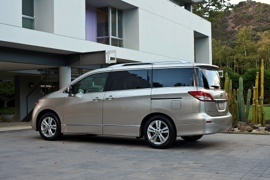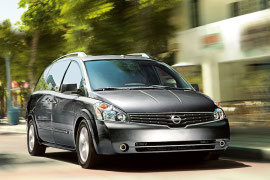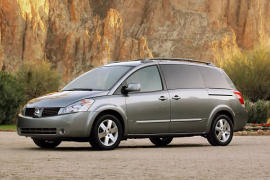NISSAN Quest Models/Series Timeline, Specifications & Photos
First production year: 2004
Engines: Gasoline
Body style: Van
The fourth generation of the Nissan Quest was introduced at the 2010 Los Angeles Auto Show. While other car-makers started to drop their big MPVs, the Japanese company struggled to find its customers.
From 2004 'till 2009, the MPV sales dropped from 1.1 million units to a mere 400.000. It was understandable why most of the car-makers didn't want to go there anymore. The customers already moved toward the SUV segment. But Nissan kept the big family car. It wasn't a smart choice.
The tall minivan tried to look sportier in a segment where that was the least attribute someone expected. The trapezoidal grille and the cat-eye headlights style made the car look somehow aggressive. An ascending sculpted line on the side improved the dynamic appearance. In the back, a flat and vertical tailgate with a roof-spoiler on top ended the MPV design.
The interior was an important aspect of the Quest. The dashboard styling looked inspired by the sportier sedans such as the Altima. The in-dash gear selector was close to the steering wheel. The three-dial instrument cluster placed the speedometer in the middle. The Bose sound system was offered on the options list, along with a navigation unit. The seven-seat configuration with two captain chairs on the second row added more comfort to the vehicle. Even the last three-seat bench in the back was good for full-grown adults.
The Quest was offered with a 3.5-liter under the hood that offered 260 hp. It was mated as standard to a CVT. That type of gearboxes is known for being efficient, but not sporty. Yet, the Quest offered reasonable 0 to 60 mph (0 to 97 kph) times and still being fuel-efficient in its class.
In its quest to conquer the MPV market, Nissan introduced a final facelift for the Quest in 2008 for the 2009 model year, when it changed the generation.
While the world struggled with the world economic crisis and the carmakers suffered losses, Nissan showed no mercy and facelifted the Quest to get more attention from its customers. It wasn't a big, or essential, update, but it was something to keep its clients.
From the outside, the Quest was not the best-looking vehicle on the market. It wasn't even the best-looking Nissan, but it followed the Tiida/Versa's design language. The flowing Nissan grille with angular front bumper fascia offered an aggressive stance at the front. The door's handles were chromed to induce a luxurious feeling for its customers.
Inside, Nissan installed up to seven seats on three rows. Thanks to its wide rear sliding doors, the access to them were straightforward, thanks to the sliding rear doors. The dashboard was wide and uncluttered by unnecessary curves and storage bins. Nissan arranged most of the buttons on the center stack, next to the gear selector. The carmaker installed glass-roof panels over the passenger's area fitted with individual blinds to make the vehicle more appealing. The third-row seats fold flat under the trunk floor, resulting in a completely flat loading area for extra storage room.
Under the hood, Nissan offered only one powertrain option carried over from the Maxima. It featured a 3.5-liter V6 paired to a 6-speed automatic.
More practical and more comfortable than an SUV, the Nissan Quest was a minivan that looked and felt different from any other available options on the market. Why?
Aesthetically, the Quest featured a big grille reminiscent of the sporty Nissan Maxima, while looking from the sides, the Quest had bold fender flares that ran along the shoulder line and curved up to the rear. The Quest did not feature a flat roof as most minivans do, thus the vehicle looked smaller than it actually was.
Fitted with the V6 engine, the Quest was also enjoyable to drive. The unit was borrowed from the 350Z sports car and was mated with a 5-speed automatic transmission that was as smooth as the ones that came with luxurious cars.
The Nissan Quest was available in three trim levels: S, SL and SE. The base model featured air-conditioning, dual sliding doors, power mirrors, 16-inch steel alloys and a 4-speed automatic transmission. Bigger alloy wheels could be ordered with a package that also added a rear sonar system for an extra fee.
With the SL trim level, the Quest was equipped with 16-inch alloys, adjustable foot pedals, a power sliding door on the right, a power liftgate and more features with an optional package that included side-impact air bags, heated front seats and the rear sonar system.
Moving to the top-of-the-range, the package included 17-inch alloys, a Vehicle Dynamic Control anti-skid system, a 5-speed automatic transmission, a 10-speaker premium sound system, Skyview rear roof panels, dual-zone climate control, full-length rear overhead console and a power roof.


